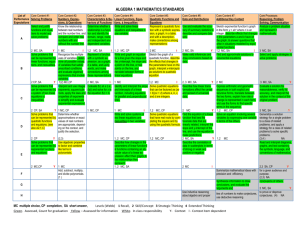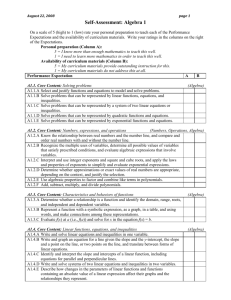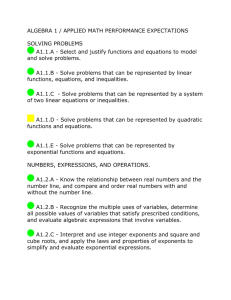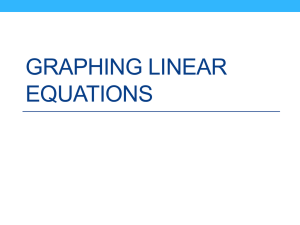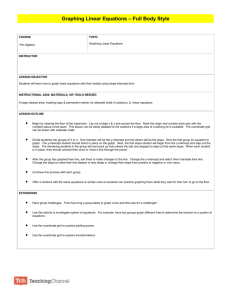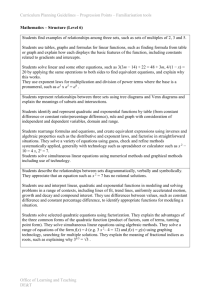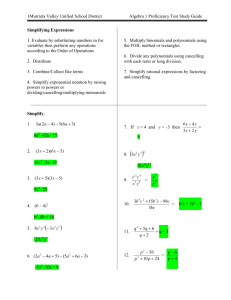Algebra 1
advertisement
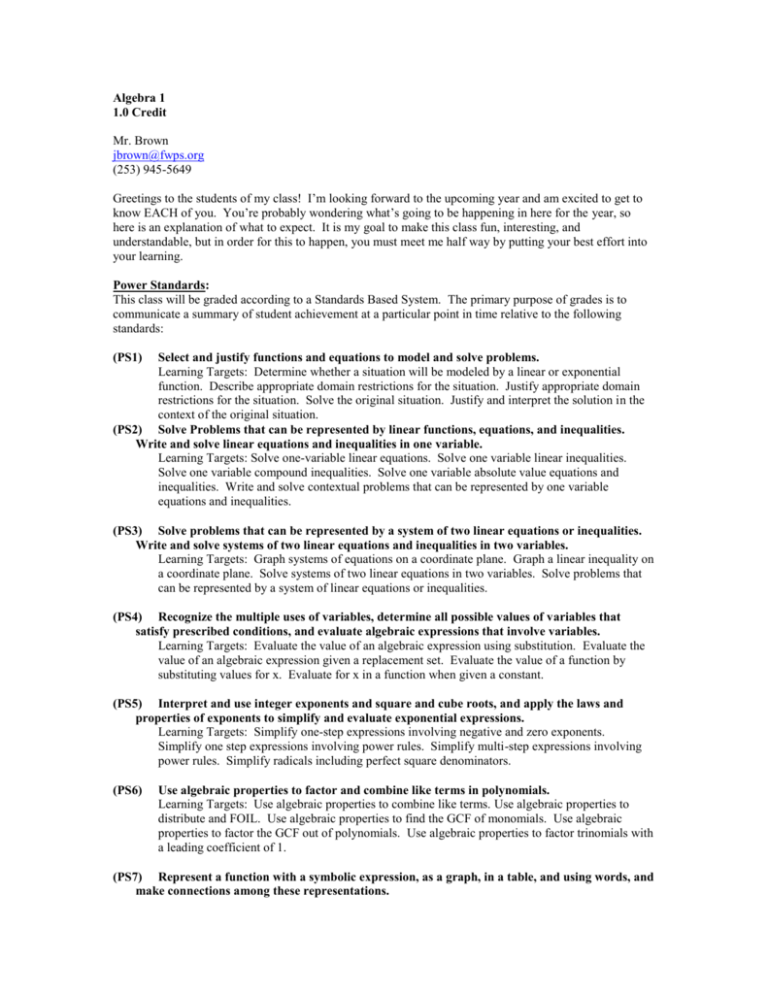
Algebra 1 1.0 Credit Mr. Brown jbrown@fwps.org (253) 945-5649 Greetings to the students of my class! I’m looking forward to the upcoming year and am excited to get to know EACH of you. You’re probably wondering what’s going to be happening in here for the year, so here is an explanation of what to expect. It is my goal to make this class fun, interesting, and understandable, but in order for this to happen, you must meet me half way by putting your best effort into your learning. Power Standards: This class will be graded according to a Standards Based System. The primary purpose of grades is to communicate a summary of student achievement at a particular point in time relative to the following standards: (PS1) Select and justify functions and equations to model and solve problems. Learning Targets: Determine whether a situation will be modeled by a linear or exponential function. Describe appropriate domain restrictions for the situation. Justify appropriate domain restrictions for the situation. Solve the original situation. Justify and interpret the solution in the context of the original situation. (PS2) Solve Problems that can be represented by linear functions, equations, and inequalities. Write and solve linear equations and inequalities in one variable. Learning Targets: Solve one-variable linear equations. Solve one variable linear inequalities. Solve one variable compound inequalities. Solve one variable absolute value equations and inequalities. Write and solve contextual problems that can be represented by one variable equations and inequalities. (PS3) Solve problems that can be represented by a system of two linear equations or inequalities. Write and solve systems of two linear equations and inequalities in two variables. Learning Targets: Graph systems of equations on a coordinate plane. Graph a linear inequality on a coordinate plane. Solve systems of two linear equations in two variables. Solve problems that can be represented by a system of linear equations or inequalities. (PS4) Recognize the multiple uses of variables, determine all possible values of variables that satisfy prescribed conditions, and evaluate algebraic expressions that involve variables. Learning Targets: Evaluate the value of an algebraic expression using substitution. Evaluate the value of an algebraic expression given a replacement set. Evaluate the value of a function by substituting values for x. Evaluate for x in a function when given a constant. (PS5) Interpret and use integer exponents and square and cube roots, and apply the laws and properties of exponents to simplify and evaluate exponential expressions. Learning Targets: Simplify one-step expressions involving negative and zero exponents. Simplify one step expressions involving power rules. Simplify multi-step expressions involving power rules. Simplify radicals including perfect square denominators. (PS6) Use algebraic properties to factor and combine like terms in polynomials. Learning Targets: Use algebraic properties to combine like terms. Use algebraic properties to distribute and FOIL. Use algebraic properties to find the GCF of monomials. Use algebraic properties to factor the GCF out of polynomials. Use algebraic properties to factor trinomials with a leading coefficient of 1. (PS7) Represent a function with a symbolic expression, as a graph, in a table, and using words, and make connections among these representations. Learning Targets: Represent a function as a verbal description. Represent a function as a table. Represent a function as a graph. Represent a function as a symbolic expression. Make connections among a verbal description, table, graph, and symbolic expression. (PS8) Evaluate f(x) at a (i.e., f(a)) and solve for x in the equation f(x) = b.) Learning Targets: Evaluate the symbolic expression of a function. Evaluate f(x) for any given value of x. Solve for x in the equation f(x) = b. (PS9) Write and graph an equation for a line given the slope and the y-intercept, the slope and a point on the line, or two points on the line, and translate between forms of linear equations. Learning Targets: Write an equation given the slope and y-intercept. Write an equation given the slope and a point on the line. Write an equation given two points on the line. Graph linear equations. Translate between forms of linear equations. (PS10) Identify and interpret the slope and intercepts of a linear function, including equations for parallel and perpendicular lines. Learning Targets: Identify the slope of a linear function. Identify the y-intercept of a linear function. Identify slope and y-intercept of parallel and perpendicular lines. Interpret the slope of a linear function. Interpret the y-intercept of a linear function. (PS11) Describe how changes in the parameters of linear functions and functions containing an absolute value of a linear expression affect their graphs and the relationships they represent. Learning Targets: Graph functions with absolute value and direct variation. Describe how changes in the parameters of linear functions affect their graph and the relationships they represent. Describe how changes in the parameters of functions with absolute value affect their graph and the relationships they represent. Describe how changes in the parameters of direct variation affect their graph and the relationships they represent. (PS12) Represent a quadratic function with a symbolic expression, as a graph, in a table, and with a description, and make connections among the representations. Learning Targets: Represent a quadratic function with a symbolic expression. Represent a quadratic function with a table. Represent a quadratic function with a graph. Represent a quadratic function with a description. Make connections among the representations of a quadratic function. (PS13) Find the equation of a linear function that best fits bivariate data that are linearly related, interpret the slope and y-intercept of the line, and use the equation to make predictions. Learning Targets: Describe the correlation of data in scatterplots in terms of strong or weak and positive or negative. Find the equation of a linear function that best fits bivariate data that are linearly related. Interpret the slope and y-intercept of the line. Use the equation to make predictions. (PS14) Sketch the graph of a quadratic function, describe the effects that changes in the parameters have on the graph, and interpret the x-intercepts as solutions to a quadratic equation. Sketch the graph for an exponential function of the form y = a𝒃𝒏 where n is an integer, describe the effects that changes in the parameters a and b have on the graph, and answer questions that arise in situations modeled by exponential functions. Learning Targets: Sketch the graph of a quadratic function. Sketch the graph of an exponential function. Describe the effects that changes in the parameters have on a quadratic function. Describe the effects that changes in the parameters of a and b have on an exponential function. Interpret x-intercepts of quadratic functions as solutions. (PS 15) Develop fluency in operations with real numbers, vectors, matrices, using mental computation or paper-pencil calculations for simple cases and technology for more complicated cases. Learning Targets: Understand the meaning of operations and how they relate to one another using order of operations. Compute operations with fractions fluently and make reasonable estimates. Compute operations with decimals fluently and make reasonable estimates. Compute operations with integers fluently and make reasonable estimates. Understand relationships among numbers by converting fractions, decimals, and percents. Major Course Project and Assignments: Each of the above Power Standards will be assessed as being Met or In Progress depending on demonstration of the learning targets. Each learning target requires at minimum two pieces of evidence in order to demonstrate mastery. This evidence will be collected in the form of summative tests, in-class quizzes, collections of evidence of mastery in a portfolio, or when appropriate, teacher observation. Assignments and Daily Practice (Evaluative Assessments) Assignments will be given daily, in the context of drill and practice or as a follow-up to an in-class activity and are all about practice and learning. Each assignment will either be due that day or the following day in class. Effort is the most important tool for success in this area. If you do the problems, show your work, and turn it in on time, you will be well-equipped to monitor your progress towards meeting the standard, and you will know what adjustments to make or gaps to fill prior to your summative assessments. Homework will be collected daily and recorded to monitor your progress toward meeting standard. A collection of your daily assignments and work can be used as one piece of evidence of mastery of a learning target. Tests/Quizzes/Projects (Summative Assessments) Tests: These are the assessment pieces used to determine if standard is met. They come at the end of a unit, and will assess the various learning targets of the Power Standards above. Tests will often focus on one Power Standard and its learning targets, but might also focus on multiple Power Standards and learning targets at once. Projects can also be assigned as an alternative method of assessing the degree to which you understand the Power Standards. Summative assessments and quizzes will provide you with many opportunities to show evidence of mastery of the learning targets. Your grade in the class will be determined by the number of assessed Power Standards you have mastered according to the following sliding scale: High School Credit Bearing Grade Chart (HSCBG Chart) # of Standards assessed # of “Y”s required for Letter Grade Equivalent A B C P IP I F 15 13 12 11 NA NA 10 8 or less 14 12 11 10 NA NA 9 7 or less 13 11 10 9 NA NA 8 7 or less 12 10 9 8 NA NA 7 6 or less 11 10 9 8 NA NA 7 6 or less 10 9 8 7 NA NA 6 5 or less 9 8 7 6 NA NA 5 4 or less 8 7 6 5 NA NA 4 3 or less 7 6 5 4 NA NA 3 2 or less 6 5 4 3 NA NA 2 1 or less 5 5 4 3 NA NA 2 1 4 4 3 2 NA NA 1 0 3 3 NA NA 2 1 NA 0 2 NA NA NA 2 1 NA 0 Note: A Power Standard will not be given a “Y” until a student has demonstrated mastery of each of its learning targets twice. Safety Net: The grade in this course will be determined at the power standard level, as outlined above, or by percentage of learning targets achieved versus total assessed, whichever results in the higher grade for the student. This Safety Net will be calculated as follows Learning Target Grade Safety Net: 90% or higher of total Learning Targets Assessed ----- A 80% - 89% of total Learning Targets Assessed -------- B 70%- 79% of total Learning Targets Assessed -------- C Below 70% of total Learning Targets Assessed ------ F Note: The online grading system and reporting website (GO2) will only reflect your grade calculated at the Power Standard level. For this reason, The Safety Net grade will only be put in by the instructor at semester time. However, students will be given frequent updates of their progress in class in relation to the learning target Safety Net. Make-Up Policy: Attendance: Attendance is important for your success in this class. If your absences are excused, you will be able to make up any assessments missed during the absence. However, make sure you are prepared to take the test immediately upon your return…be prepared. If you knew about the test, you will be expected to be ready. Retake Policy for Thomas Jefferson: TJHS students may have at least two re-attempts to meet each learning target. Students will have options for doing this both within and outside of the school day. Prior to re-attempting the target, students may be required to: Set up a time/location that will work for both them and their teacher. Demonstrate that they are prepared for the re-attempt. Teachers will provide each student with at least two re-attempts on the learning target in a timely fashion (within two weeks unless there are extenuating circumstances). STUDENT SIGNATURE: PARENT SIGNATURE:



